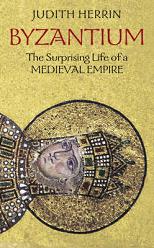
Byzantium
Judith Herrin
392 pages including index
published in 2008
In her introduction Judith Herrin explains she was inspired to write this book by a conversation she had with two workmen knocking on her office door. They had been doing repairs on the building in King's College where she worked and noticed the sign on her office: "Professor of Byzantine History" and were interested enough to ask what this meant. As she puts it, she found herself "trying to explain briefly what Byzantine history is to two serious builders in hard hats and heavy boots". From their suggestion that she should write a book explaining Byzantium to people like (or me, for that matter) who knew little if anything about the subject, this book arose. Byzantium -- The Surprising Life of a Medieval Empire is an attempt to explain more than a thousand years of Byzantine history, as well as the many facets of this history.
It sounded like the perfect book to read, now that I had temporarily exhausted my library's stock of interesting looking books on Roman history. Byzantium was after all a clear succesor to Rome, I knew little about it and Herrin's book easily passed the page 37 test. She isn't a historian I was aware of before, but with Byzantium she's become one of the names I'll pay attention to when looking for new books, no matter the subject. She manages to write a good introduction to a complex subject without talking down to the reader.
Byzantium follows a roughly chronological order, from the city's trasnformation from Byzantium to Constantinople as the new capital of the (Eastern) Roman Empire, to its fall at the hands of the Turks. The book is divided into four parts: "foundations of Byzantium", in which Herrin examines both the earliest history of the city and in a more general sense the foundations of the empire itself. This is followed by "the transition from Ancient to Medieval, which starts with the sudden arrival of the Arabs into Middle Eastern history, driven by Islam and conquering most of the old Eastern Roman Empire, forcing Byzantium to adapt to the new realities. In the third part, "Byzantium becomes a Medieval State", Herrin examines the realities of Byzantium after the loss of most of its empire to the Arabs. Finally, the fourth part, "varieties of Byzantium" treats the Empire's downfall at the hand of the Crusaders who conquered the city in 1204 and splintered the empire, with the Turks delivering the final blow in 1453.
Each part consists of several chapters, which both continue the history of Byzantium and focus on a particular aspect of its history and culture. For example in the first part there are chapters on the City of Constantinople, the East Roman Empire as well as on the Hagia Sophia, Roman Law and the Ravonna mosaics. Again in part III there are chapters on Greek Fire, the Byzantine economy but also on Mount Athos and "Venice and the fork". Each chapter is relatively short, on average some fifteen to twentyfive pages long. There isn't much room for any in-depth examinations of any of the subjects Herrin looks at, but then this was meant as a general introduction to the richness and wonders of Byzantine history. As such, it succeeds.
It's easy to think of Byzantium as a relic of Antiquity, an anarchronism in an increasingly medieval world. As the full title of this book -- Byzantium -- The Surprising Life of a Medieval Empire -- makes clear this is wrong. While Byzantium started out Roman, once the Roman Empire fragmented due to the "barbarian" invasions of the fourth and fifth centuries it slowly developed its own identity. With the unexpected rise of the Arab tribes in the seventh century conquering the old African and Middle Eastern Roman provinces, this process was accelerated. It meant the end of any further attempts to restore the Roman Empire and forced Byzantium to concentrate on the defence of its provinces in the Balkans and Anatolia.
In a wider European perspective Herrin argues that the survival of Byzantium as a Christian state despite the odds against it in the seventh century meant that the penetration of Islam into Europe, other than in Spain and Sicily was delayed for several centuries, that it couldn't overrun and conquer the entirety of the old Roman Empire. This created a space in which the European nations could develop their own identities, not just because they weren't conquered, but also because the old eastern provinces of the Roman Empire were now cut off from them. On a cultural level, the survival of Byzantium, despite the continuing threat of Arab and later Turkish invasion was also important, in that it preserved artistic traditions dating back to Roman times. Herrin also shows that Byzantine culture is worthy of attention on its own merits.
Herrn can of course only deliver a limited overview of why Byzantine history is worth studying in her book, but she argues her case well. Recommended.